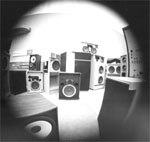On advice of my FOH engineer, of Technical Support Consultants, Albuquerque, NM, I grabbed two of these for a trail. One in the pro gear, road rack; the other here at home with the 4345's.
The XR1001 is a 24dB/octave crossover, with adjustable crossover point. And, as GordonW was posting today, this has an adjustable "response", allowing for modifying the curve in the area of f0, while maintaining the 24dB slopes.
Results were most impressive. In the pro road gear, my EV Eliminator mains have not before sounded so clear, and so effortless. Punchier bass, and very clear highs. There, I'm using a 75Hz crossover point, with -3dB response and +3dB for the LF (subs).
At home with the 4345's, Ian and I went through A/B rounds against the 5234A. At the end, we both preferred the Ashly XR1001. The bass was more distinct, and had very good punch. There was notably much better definition right around the crossover point (290Hz). The HF was the biggest surprise, being more "open", and the horns were much less "beamy" (although they were not bad with the 5234A - but were certainly better with the XR1001). The soundstage was noticeably deeper. Overall, a wonderful, wonderful sound.
Mr. Widget got a run at the XR1001 too - with his new Clones. He too is quite impressed, and has now gone and got one. I'll let him add his commentary, but with his wooden horns the soundstage was pretty phenomenal. Really, really nice.
So, for now I've retired the 5234A, and we're running with the XR1001. If you get a chance, I'd suggest you "give it a go..." (Ian parlance...

).
http://www.ashly.com/xr-series.htm




 Reply With Quote
Reply With Quote









 I'm thinking along the lines of the JBL 5235 x-over & 2 JBL 5547A eq's, and selling the ashly gear. I know these units are highly touted here (ashly). However, the jbl x-over has a programable 6db bass boost at 20,30, and 40 hz. Now say I do my thing on the x-over and eq. (change all resistors to 1% metal film, change out all electrolytics to Panny FC's, change out the polester film caps for metalized polypropylene, and yada yada? Has that been tried?
I'm thinking along the lines of the JBL 5235 x-over & 2 JBL 5547A eq's, and selling the ashly gear. I know these units are highly touted here (ashly). However, the jbl x-over has a programable 6db bass boost at 20,30, and 40 hz. Now say I do my thing on the x-over and eq. (change all resistors to 1% metal film, change out all electrolytics to Panny FC's, change out the polester film caps for metalized polypropylene, and yada yada? Has that been tried? 